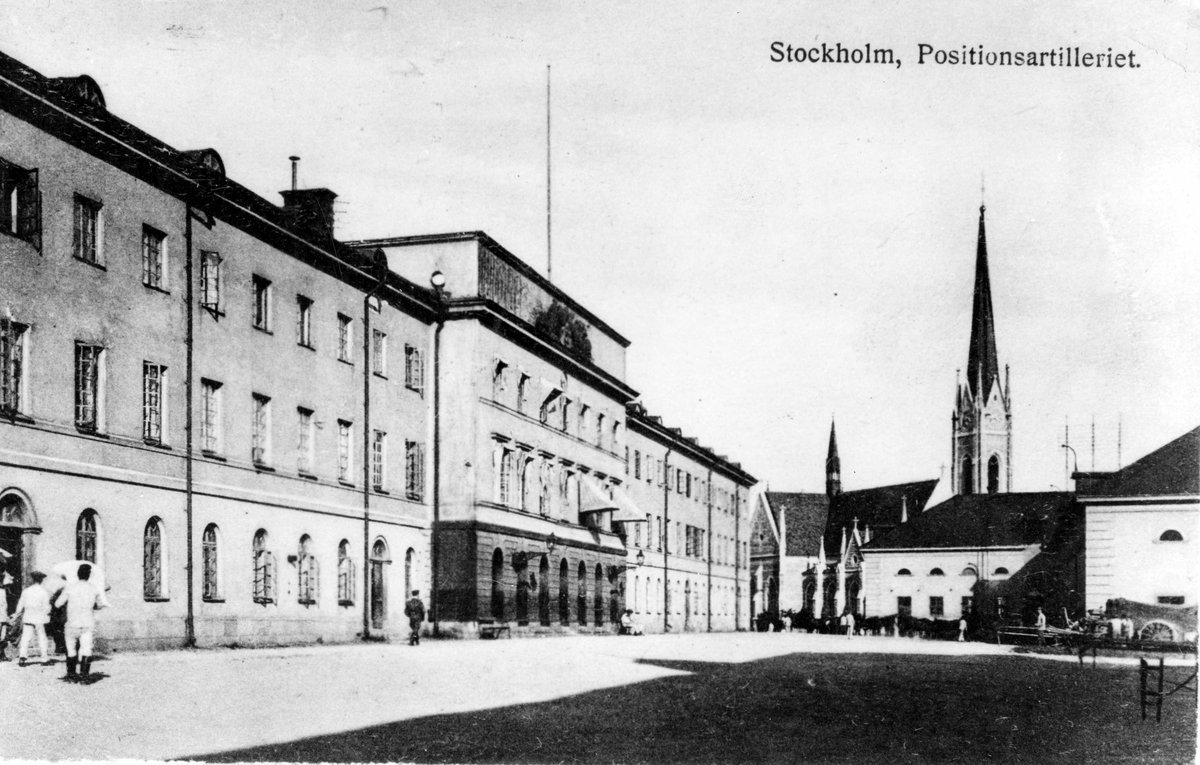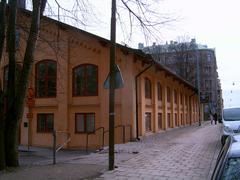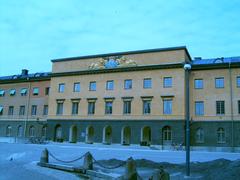
Kvarteret Krubban: Visiting Hours, Tickets, and Historical Significance in Stockholm
Date: 14/06/2025
Introduction
Kvarteret Krubban, located in Stockholm’s dynamic Östermalm district, stands as a vivid tapestry of Swedish history—melding military heritage, evolving architecture, and modern cultural engagement. Originally acquired by the Swedish Crown in 1804 as a military garrison, this quarter has transitioned from fortified barracks to a civic landmark, now housing the Swedish History Museum and offering diverse experiences for visitors of all ages. Its blend of preserved historic buildings, innovative playgrounds, and proximity to major cultural sites makes it a must-visit destination for anyone interested in Stockholm’s past and present (Statens Fastighetsverk; History of Stockholm).
Table of Contents
- Early Origins and Urban Development
- Military Era and Architectural Transformation
- The Swedish History Museum: From Barracks to Exhibition Halls
- Cultural and Community Spaces
- Visiting Information
- Frequently Asked Questions
- Nearby Attractions
- Summary and Visitor Recommendations
- References
Early Origins and Urban Development
Kvarteret Krubban’s story begins in the context of Stockholm’s expansion beyond its medieval core in the 17th and 18th centuries. Östermalm, once a rural fringe, was gradually urbanized as the city grew, with areas like Krubban designated for strategic state and military use by the early 1800s (History of Stockholm).
Military Era and Architectural Transformation
In 1804, the Swedish Crown purchased the Krubban site to establish new garrison facilities. Architect Fredrik Blom designed a series of regimental buildings—characterized by robust, neoclassical forms and innovative construction methods—that anchored Stockholm’s military infrastructure (Statens Fastighetsverk). The area’s strategic location and ample space facilitated its use as a base for the prestigious Life Guards of Horse, with stables, riding halls, and training grounds shaping its urban fabric.
By the early 20th century, as military needs shifted, the barracks were gradually vacated and identified for new civic purposes.
The Swedish History Museum: From Barracks to Exhibition Halls
In 1929, the former military site was chosen as the home for the Swedish History Museum (Historiska Museet). Architects Bengt Romare and Georg Scherman led an ambitious redesign, preserving the fortress-like exterior while transforming the interior into spacious, modern galleries. The museum complex, completed between 1934 and 1939, features four wings around a central courtyard and an iconic main entrance with bronze doors sculpted by Bror Marklund in the 1950s (Statens Fastighetsverk).
Inside, chronological exhibitions guide visitors through Swedish history, from prehistory to the Middle Ages. The celebrated Guldrummet (Gold Room), created in 1994 beneath the courtyard, houses invaluable gold and silver artifacts in a secure, atmospheric vault. Adaptations like the Blå hallen (Blue Hall) further balance historic preservation with modern needs, providing spaces for art displays and public programs.
Cultural and Community Spaces
Beyond the museum, Kvarteret Krubban’s urban landscape has continued to evolve. One standout feature is Krubbans lekplats, an inclusive playground opened in 2019. Its design incorporates historical motifs—like gabled rooftops and windmill replicas—as playful structures, inviting children and families to interact with Sweden’s architectural heritage in creative ways (parker.stockholm; Stockholmskällan). Artists Johan Ferner Ström and Tor Svae helped realize this vision, ensuring accessibility and engagement for all ages.
The courtyards, landscaped gardens, and surrounding green spaces provide residents and visitors with a tranquil oasis amidst the city bustle, making Krubban a lively community hub.
Visiting Information
Opening Hours and Tickets
- Swedish History Museum:
Open Tuesday to Sunday, 10:00–17:00. Closed Mondays and major holidays.
Admission to permanent exhibitions is free; some special exhibitions or guided tours may require tickets (Historiska Museet). - Krubbans lekplats (Playground):
Open year-round from dawn to dusk. Free of charge (parker.stockholm).
Accessibility
- The museum and playground are wheelchair accessible, with elevators, ramps, and accessible restrooms.
- Some historic courtyards feature cobblestones or uneven ground; visitors with mobility challenges are advised to plan accordingly.
- Service animals are permitted.
Guided Tours and Events
- Guided tours in Swedish and English are offered regularly at the museum.
- Tours may be booked online or on-site, with some available on a walk-in basis.
- The museum hosts lectures, workshops, and family activities year-round.
Getting There
- By Public Transport:
Nearest metro: Östermalmstorg (10-minute walk); Karlaplan station is also nearby. Multiple bus lines serve Linnégatan and Narvavägen. - By Car:
Limited street parking is available; public transport is recommended. - By Bike or Foot:
Easily accessible via Stockholm’s extensive pedestrian and cycling routes.
Facilities and Amenities
- Restrooms and baby-changing facilities are available at the museum.
- Museum café offers light meals and refreshments.
- Free Wi-Fi in public areas.
- Picnic spots are found in the gardens and playground.
Frequently Asked Questions (FAQ)
Q: What are the Swedish History Museum’s opening hours?
A: Tuesday to Sunday, 10:00–17:00; closed Mondays.
Q: Do I need a ticket to visit?
A: General admission is free. Special exhibitions or tours may have a fee.
Q: Is the area family-friendly?
A: Yes. The playground and museum offer programs for children and families.
Q: Are guided tours available?
A: Yes, in Swedish and English. Check the museum’s website for schedules.
Q: Is Krubban wheelchair accessible?
A: Yes, though some outdoor surfaces are uneven.
Q: Can I bring my dog?
A: Dogs are allowed in outdoor public areas but not inside the museum or playground.
Nearby Attractions
- Royal Dramatic Theatre
- Humlegården Park
- Östermalms Saluhall (historic market hall)
- Vasa Museum and Nordic Museum (on Djurgården)
- Army Museum (within walking distance)
Summary & Visitor Recommendations
Kvarteret Krubban is a living example of Stockholm’s ability to harmonize its rich history with the demands of modern urban life. From its inception as a royal garrison to its current role as a cultural and recreational hub, Krubban encapsulates Sweden’s national narrative.
- Free museum admission and easily accessible playgrounds make it ideal for families, history enthusiasts, and cultural explorers alike.
- Its location in Östermalm, close to transport and major attractions, ensures convenience for all visitors.
- Check official sites before visiting for up-to-date hours and event details.
For a fuller experience, consider exploring nearby museums, parks, and historical landmarks, and use the Audiala app for audio guides and curated tours for Stockholm’s historical sites.
References
- History of Stockholm, Wikipedia
- Statens Fastighetsverk – Historiska Museet i Stockholm
- Parker Stockholm – Krubbans Lekplats
- Stockholmskällan – Kvarteret Krubban
- Swedish History Museum Official Website
- Visit Stockholm – Kvarteret Krubban and Tours
- Visit Sweden – Stockholm Attractions
Enjoy your visit to Kvarteret Krubban, where stories of Sweden’s past meet the creativity and vibrancy of today’s Stockholm!








































































































































































